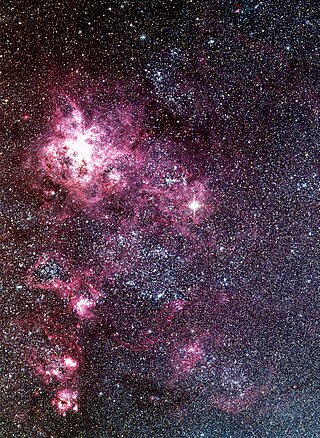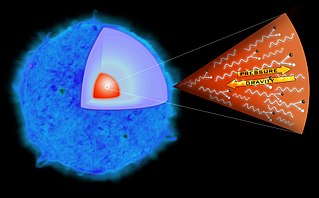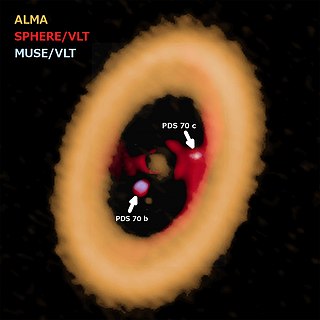
A supernova is a powerful and luminous explosion of a star. A supernova occurs during the last evolutionary stages of a massive star or when a white dwarf is triggered into runaway nuclear fusion. The original object, called the progenitor, either collapses to a neutron star or black hole, or is completely destroyed to form a diffuse nebula. The peak optical luminosity of a supernova can be comparable to that of an entire galaxy before fading over several weeks or months.

SN 1987A was a type II supernova in the Large Magellanic Cloud, a dwarf satellite galaxy of the Milky Way. It occurred approximately 51.4 kiloparsecs from Earth and was the closest observed supernova since Kepler's Supernova. 1987A's light reached Earth on February 23, 1987, and as the earliest supernova discovered that year, was labeled "1987A". Its brightness peaked in May of that year, with an apparent magnitude of about 3.

First observed between August 4 and August 6, 1181, Chinese and Japanese astronomers recorded the supernova now known as SN 1181 in eight separate texts. One of only five supernovae in the Milky Way confidently identified in pre-telescopic records, it appeared in the constellation Cassiopeia and was visible and motionless against the fixed stars for 185 days. F. R. Stephenson first recognized that the 1181 AD "guest star" must be a supernova, because such a bright transient that lasts for 185 days and does not move in the sky can only be a galactic supernova.

SN 2005df was a Type Ia supernova in the barred spiral galaxy NGC 1559, which is located in the southern constellation of Reticulum. The event was discovered in Australia by Robert Evans on the early morning of August 5, 2005 with a 13.8 magnitude, and was confirmed by A. Gilmore on August 6. The supernova was classified as Type Ia by M. Salvo and associates. It was positioned at an offset of 15.0″ east and 40.0″ north of the galaxy's nucleus, reaching a maximum brightness of 12.3 on August 18. The supernova luminosity appeared unreddened by dust from its host galaxy.

SN 1994D was a Type Ia supernova event in the outskirts of galaxy NGC 4526. It was offset by 9.0″ west and 7.8″ south of the galaxy center and positioned near a prominent dust lane. It was caused by the explosion of a white dwarf star composed of carbon and oxygen. This event was discovered on March 7, 1994 by R. R. Treffers and associates using the automated 30-inch telescope at Leuschner Observatory. It reached peak visual brightness two weeks later on March 22. Modelling of the light curve indicates the explosion would have been visible around March 3-4. A possible detection of helium in the spectrum was made by W. P. S. Meikle and associates in 1996. A mass of 0.014 to 0.03 M☉ in helium would be needed to produce this feature.

NGC 1566, sometimes known as the Spanish Dancer, is an intermediate spiral galaxy in the constellation Dorado, positioned about 3.5° to the south of the star Gamma Doradus. It was discovered on May 28, 1826 by Scottish astronomer James Dunlop. At 10th magnitude, it requires a telescope to view. The distance to this galaxy remains elusive, with measurements ranging from 6 Mpc up to 21 Mpc.

A pair-instability supernova is a type of supernova predicted to occur when pair production, the production of free electrons and positrons in the collision between atomic nuclei and energetic gamma rays, temporarily reduces the internal radiation pressure supporting a supermassive star's core against gravitational collapse. This pressure drop leads to a partial collapse, which in turn causes greatly accelerated burning in a runaway thermonuclear explosion, resulting in the star being blown completely apart without leaving a stellar remnant behind.

SN 1998aq is a nearby supernova located in the intermediate spiral galaxy NGC 3982, offset 18″ west and 7″ of the galactic nucleus. It was discovered April 13, 1998 by amateur astronomer Mark Armstrong and was confirmed by fellow British amateur Ron Arbour; both members of the U.K. Supernova/Nova Patrol. The event was not visible on a prior check by Armstrong made April 7. It reached peak brightness on April 27, and 15 days later had declined by 1.14 magnitudes in the B (blue) band.

NGC 3938 is an unbarred spiral galaxy in the Ursa Major constellation. It was discovered on 6 February 1788 by William Herschel. It is one of the brightest spiral galaxies in the Ursa Major South galaxy group and is roughly 67,000 light years in diameter. It is approximately 43 million light years away from Earth. NGC 3938 is classified as type Sc under the Hubble sequence, a loosely wound spiral galaxy with a smaller and dimmer bulge. The spiral arms of the galaxy contain many areas of ionized atomic hydrogen gas, more so towards the center.

SN 1895B was a supernova event in the irregular dwarf galaxy NGC 5253, positioned 16″ east and 23″ north of the galactic center. It is among the closest known extragalactic supernova events. The supernova was discovered by Williamina Fleming on December 12, 1895 after noticing an unusual spectrum on a photographic plate taken July 18, 1895, and was initially given the variable star designation Z Centauri. The light curve is consistent with an event that began ~15 days before the discovery plate was taken, and this indicates the supernova reached a peak visual magnitude of up to 8.49±0.03.

SN 2014J was a type-Ia supernova in Messier 82 discovered in mid-January 2014. It was the closest type-Ia supernova discovered for 42 years, and no subsequent supernova has been closer as of 2023. The supernova was discovered by chance during an undergraduate teaching session at the University of London Observatory. It peaked on 31 January 2014, reaching an apparent magnitude of 10.5. SN 2014J was the subject of an intense observing campaign by professional astronomers and was bright enough to be seen by amateur astronomers.

A zombie star is a hypothetical result of a Type Iax supernova which leaves behind a remnant star, rather than completely dispersing the stellar mass. Type Iax supernovae are similar to Type Ia, but have a lower ejection velocity and lower luminosity. Type Iax supernovae may occur at a rate between 5 and 30 percent of the Ia supernova rate. Thirty supernovae have been identified in this category.

NGC 157 is an intermediate spiral galaxy in the constellation of Cetus, positioned about 4° east of the star Iota Ceti. This galaxy can be viewed from suburban skies using a moderate-sized telescope. It was discovered on December 13, 1783 by William Herschel. The compiler of the New General Catalogue, John Louis Emil Dreyer noted that NGC 157 was "pretty bright, large, extended, between 2 considerably bright stars". It is a relatively isolated galaxy; the nearest other galaxy of comparable luminosity lies at a separation of 4.2 Mly (1.3 Mpc).

NGC 4424 is a spiral galaxy located in the equatorial constellation of Virgo. It was discovered February 27, 1865 by German astronomer Heinrich Louis d'Arrest. This galaxy is located at a distance of 13.5 million light years and is receding with a heliocentric radial velocity of 442 km/s. It has a morphological class of SB(s)a, which normally indicates a spiral galaxy with a barred structure (SB), no inner ring feature (s), and tightly-wound spiral arms (a). The galactic plane is inclined at an angle of 62° to the line of sight from the Earth. It is a likely member of the Virgo Cluster of galaxies.

NGC 6753 is a massive unbarred spiral galaxy, seen almost exactly face-on, in the southern constellation of Pavo. It was discovered by the English astronomer John Herschel on July 5, 1836. The galaxy is located at a distance of 142 million light years from the Milky Way, and is receding with a heliocentric radial velocity of 3,140 km/s. It does not display any indications of a recent interaction with another galaxy or cluster.

A circumplanetary disk is a torus, pancake or ring-shaped accumulation of matter composed of gas, dust, planetesimals, asteroids or collision fragments in orbit around a planet. Around the planets, they are the reservoirs of material out of which moons may form. Such a disk can manifest itself in various ways.

GRB 221009A also known as Swift J1913.1+1946 was an unusually bright and long-lasting gamma-ray burst (GRB) jointly discovered by the Neil Gehrels Swift Observatory and the Fermi Gamma-ray Space Telescope on October 9, 2022. The gamma-ray burst was around seven minutes long, but was detectable for more than ten hours following initial detection, and for several hours was bright enough in visible frequencies to be observable by amateur astronomers. Despite being over 2 billion light-years away, it was powerful enough to affect Earth's atmosphere, having the strongest effect ever recorded by a gamma-ray burst on the planet. The peak luminosity of GRB 221009A was measured by Konus-Wind to be ∼ 2.1 × 1047 J/s and by Fermi-GBM to be ∼ 1.0 × 1047 J/s over the 1.024s interval. A burst as energetic and as close to Earth as 221009A is thought to be a once-in-10,000-year event. It was the brightest and most energetic gamma-ray burst ever recorded, being deemed the "BOAT", or brightest of all time.

SN 2022jli is a Type Ic supernova discovered in 2022 in the spiral galaxy NGC 157 at a distance of about 23 Mpc. The light curve of the supernova exhibited oscillations that are interpreted as an interaction of a companion star of the star that exploded with a compact object, probably a neutron star or a black hole.



















